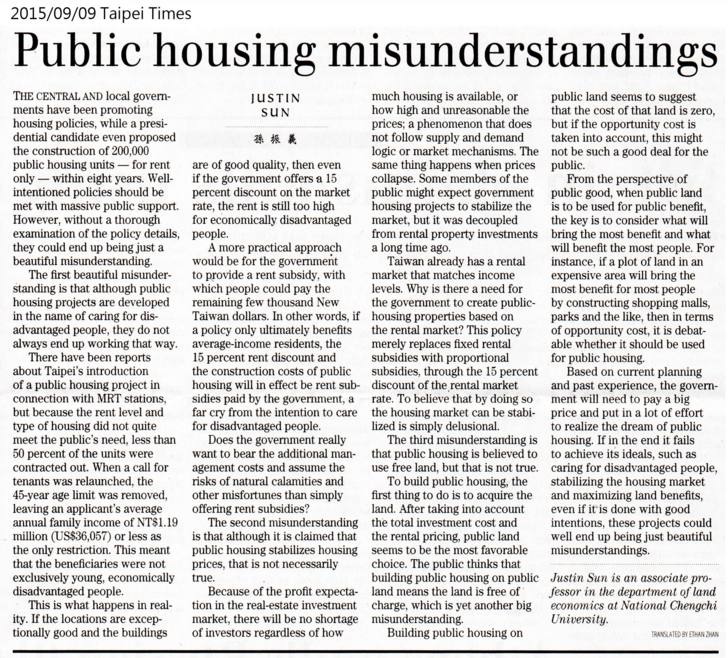The central and local governments have been promoting housing policies, while a presidential candidate even proposed the construction of 200,000 public housing units — for rent only — within eight years. Well-intentioned policies should be met with massive public support. However, without a thorough examination of the policy details, they could end up being just a beautiful misunderstanding.
The first beautiful misunderstanding is that although public housing projects are developed in the name of caring for disadvantaged people, they do not always end up working that way.
There have been reports about Taipei’s introduction of a public housing project in connection with MRT stations, but because the rent level and type of housing did not quite meet the public’s need, less than 50 percent of the units were contracted out. When a call for tenants was relaunched, the 45-year age limit was removed, leaving an applicant’s average annual family income of NT$1.19 million (US$36,057) or less as the only restriction. This meant that the beneficiaries were not exclusively young, economically disadvantaged people.
This is what happens in reality. If the locations are exceptionally good and the buildings are of good quality, then even if the government offers a 15 percent discount on the market rate, the rent is still too high for economically disadvantaged people.
A more practical approach would be for the government to provide a rent subsidy, with which people could pay the remaining few thousand New Taiwan dollars. In other words, if a policy only ultimately benefits average-income residents, the 15 percent rent discount and the construction costs of public housing will in effect be rent subsidies paid by the government, a far cry from the intention to care for disadvantaged people.
Does the government really want to bear the additional management costs and assume the risks of natural calamities and other misfortunes than simply offering rent subsidies?
The second misunderstanding is that although it is claimed that public housing stabilizes housing prices, that is not necessarily true.
Because of the profit expectation in the real-estate investment market, there will be no shortage of investors regardless of how much housing is available, or how high and unreasonable the prices; a phenomenon that does not follow supply and demand logic or market mechanisms. The same thing happens when prices collapse. Some members of the public might expect government housing projects to stabilize the market, but it was decoupled from rental property investments a long time ago.
Taiwan already has a rental market that matches income levels. Why is there a need for the government to create public-housing properties based on the rental market? This policy merely replaces fixed rental subsidies with proportional subsidies, through the 15 percent discount of the rental market rate. To believe that by doing so the housing market can be stabilized is simply delusional.
The third misunderstanding is that public housing is believed to use free land, but that is not true.
To build public housing, the first thing to do is to acquire the land. After taking into account the total investment cost and the rental pricing, public land seems to be the most favorable choice. The public thinks that building public housing on public land means the land is free of charge, which is yet another big misunderstanding.
Building public housing on public land seems to suggest that the cost of that land is zero, but if the opportunity cost is taken into account, this might not be such a good deal for the public.
From the perspective of public good, when public land is to be used for public benefit, the key is to consider what will bring the most benefit and what will benefit the most people. For instance, if a plot of land in an expensive area will bring the most benefit for most people by constructing shopping malls, parks and the like, then in terms of opportunity cost, it is debatable whether it should be used for public housing.
Based on current planning and past experience, the government will need to pay a big price and put in a lot of effort to realize the dream of public housing. If in the end it fails to achieve its ideals, such as caring for disadvantaged people, stabilizing the housing market and maximizing land benefits, even if it is done with good intentions, these projects could well end up being just beautiful misunderstandings.
Justin Sun is an associate professor in the department of land economics at National Chengchi University.
Translated by Ethan Zhan













